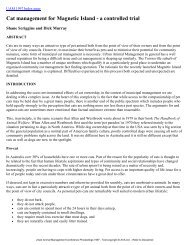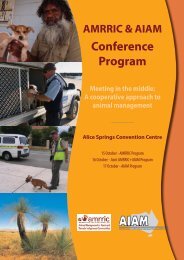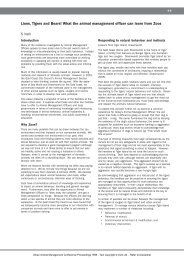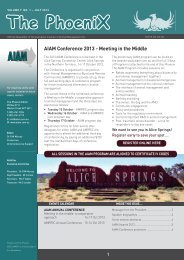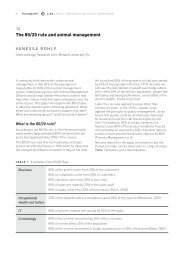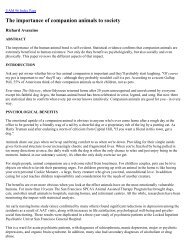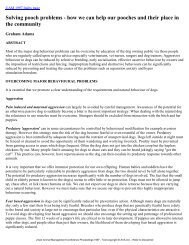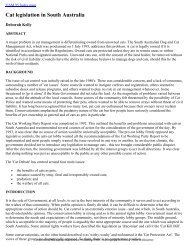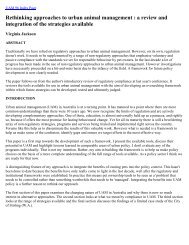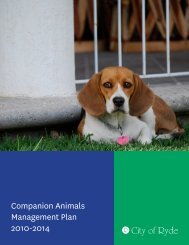Proceedings OF ThE - Australian Institute of Animal Management Inc
Proceedings OF ThE - Australian Institute of Animal Management Inc
Proceedings OF ThE - Australian Institute of Animal Management Inc
Create successful ePaper yourself
Turn your PDF publications into a flip-book with our unique Google optimized e-Paper software.
Annual Conference on <strong>Animal</strong> <strong>Management</strong> AIAM <strong>Proceedings</strong> 2012 77<br />
community that is best placed to understand how to<br />
most effectively deliver this important service.<br />
Without having the benefit “hands on” working<br />
experience in <strong>Animal</strong> <strong>Management</strong> service delivery, it<br />
is difficult for State government <strong>of</strong>ficers to know what<br />
is required, which advice is sound and genuinely in the<br />
community’s interest and which is self-serving lobbying.<br />
<strong>Animal</strong> <strong>Management</strong> has long history <strong>of</strong> emotional<br />
public volatility that can easily link to political difficulty.<br />
Issues are unfortunately <strong>of</strong>ten presented by the media<br />
in such a way as to incite public outrage, together with<br />
crisis levels <strong>of</strong> community division and political stress.<br />
If it is agreed that companion animal management is<br />
a significant issue for local government, then its only<br />
fair and reasonable that animal management policy,<br />
legislation and processes should be shaped by the<br />
community with local government being the enabler.<br />
There is strong evidence available that shows, a failure<br />
to engage with residents about how they see the future<br />
<strong>of</strong> their community, results in they becoming more <strong>of</strong> a<br />
hindrance than a help...”<br />
3. P u r p o s e<br />
Because Council has recognised the importance<br />
<strong>of</strong> pet ownership and its linkages to the quadruple<br />
bottom line (i.e., social capital, economic benefit,<br />
environmental enhancement and good governance),<br />
it makes good corporate sense to promote the<br />
Strategic <strong>Animal</strong> <strong>Management</strong> Plan to public opinion.<br />
The success <strong>of</strong> the plan, because <strong>of</strong> its ties to public<br />
opinion, which can be a malleable and fickle beast,<br />
will rely heavily on everyone involved in its design, to<br />
be “singing from the same page”. For this reason, the<br />
purpose <strong>of</strong> the plan must be stated and referred to<br />
when public opinion begins to wane.<br />
A plans purpose, should be designed around three<br />
core open questions:<br />
• ywhat is the current position? (Situation Analysis);<br />
• ywhere does the community want to be? (Goals and<br />
Objectives); and<br />
• yhow to get there? (Strategies and Action Plans).<br />
For the purpose <strong>of</strong> the exercise only, a structured<br />
“purpose <strong>of</strong> the plan” paragraph is presented as a<br />
guide:<br />
“The purpose <strong>of</strong> this plan is to document the philosophy<br />
that has been applied to its development and includes<br />
a scan <strong>of</strong> the current animal management landscape<br />
within Council’s geographical area and the service<br />
delivery models available to Council in meeting<br />
community expectations.<br />
A long term planning approach is considered absolutely<br />
necessary given the—<br />
−−importance <strong>of</strong> pet ownership to <strong>Australian</strong><br />
families,<br />
−−Council’s large capital and operating expenditure<br />
−−importance <strong>of</strong> facilitating positive pet outcomes<br />
−−need to consider population growth and the<br />
diversity <strong>of</strong> cultures within our communities.<br />
The strategic animal management plan links directly<br />
to, and supports the outcomes sought from both the<br />
Community and Corporate Plans, their goals, policies<br />
and vision for the region. The plan does however, focus<br />
directly on pet ownership and is supported by a number<br />
<strong>of</strong> strategies with key outcomes linked to achievable and<br />
cost effective action plans...”<br />
4. Strategic Objectives<br />
The plan must document clearly defined objectives<br />
that provide a sound basis for defining its long term<br />
aspirations, the short and medium term landscape,<br />
where the community wants to be at a particular<br />
time and the measures for whether the objectives<br />
can and have, in fact, been accomplished.<br />
The objectives <strong>of</strong> the plan which must be<br />
documented upfront, must be achievable and can<br />
include:<br />
• ya financial statement;<br />
• yhow infrastructure and assets will be purchased,<br />
managed and disposed <strong>of</strong>;<br />
• yhuman resource requirements;<br />
• ytrend data on population growth and cultural<br />
diversity;<br />
• yhow information access and dissemination is to<br />
be managed; and<br />
• yhow community engagement will remain a<br />
priority.<br />
5. tIMeframe<br />
A Strategic <strong>Animal</strong> <strong>Management</strong> Plan should define<br />
its lifecycle, generally 5-10 years is considered<br />
reasonable, but must be subject to regular reviews.<br />
Importantly, a Strategic <strong>Animal</strong> <strong>Management</strong> Plan<br />
should not be viewed as a static document. It must<br />
remain flexible, subject to modification and improved<br />
based on experiences in implementing actions and to<br />
manage changing circumstances.<br />
Whilst there are no crystal balls, there is strong<br />
scientific evidence, economic data and population<br />
growth statistics available from reliable sources that<br />
can accurately reflect the likely scenarios over its<br />
lifecycle.<br />
6. lIMItations<br />
A disclaimer should always accompany the Strategic<br />
Plan. The disclaimer must inform on the plans<br />
limitations and include information that relates to—<br />
• ywhere the information/data was sourced;



